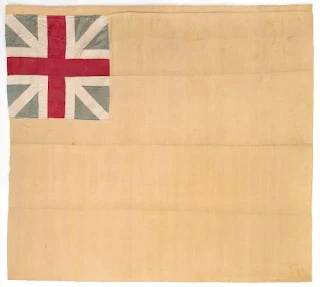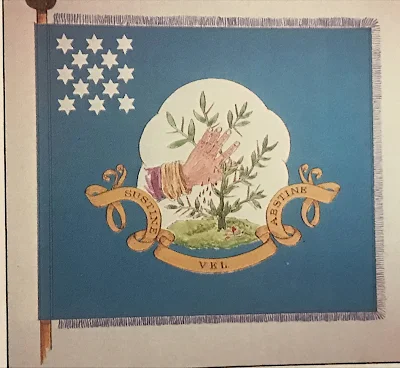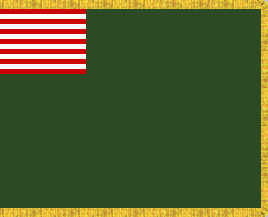Among the papers in the National Archives in Washington D.C. is a report entitled, "A Return of ye New Standards & Division Colours for ye Army of ye United States of America In Possession of Major Jonathan Gostelowe, Comy. Mily. Stores. " This return was part of a series done in July and August 1778. The report describes in great detail a series of 13 new Standards and Division Colours to be issued to regiments of the Continental Army. They describe the colors and devices on the flags and how many division colors and their colors. Because of this they are a valuable resource for anyone studying regimental colors of the Continental Army. It is not known which regiments were issued these flags although some writers have expressed suggestions.
Here is a illustration of each of the thirteen Standards as well as the information provided about them in the actual "return.". Please note that all color illustrations of these flags are from Richardson's "Standards and Colors of the American Revolution." I hope this may provide the American Revolution gamer with more information to add historically correct and colorful flags for their table top regiments. There is actually a lot of flags out there other then the same old same old.
Standard #1. Headman Color.
Number of the Standard: 1st
Their Colours: Green
No. of the Division Colours: 2
Their Colours: Blue and Yellow
The Device of the Standards: A pillow on the top of which is the cap of liberty supported by thirteen hands.
No. Of the Standards: 1st
Their Motto: This We Will Defend.
Standard #2. United Defense.
Number of the Standard: 22nd
Their Colours: Red
No. Of the Division Colours: 2
Their Colours: Green and Yellow
The Device of the Standards: An arm in armour with a drawn sword in its hand and thirteen drawn swords linked together.
No. Of the Standards: 2
Their Motto: We are Always Ready.
Standard #3. Harmonious Union.
Number of the Standard: 3rd
Their Colours: Red
No. Of the Division Colours: 2
Their Colours: Blue and Yellow
The Device of the Standards: A golden harp
No. Of the Standards: 3rd
Their Motto: Majora. Minoribus. Consanant.
Standard #4. America Triumphant.
Number of the Standard: 4th
Their Colours: yellow
No. Of the Division Colours: 2
Their Colours: Blue and red
The Device of the Standards: Britannia setting on an old stump weeping. A tree behind her withered, her spear broken, an olive branch lying at her feet, an Indian on the opposite side with his now strung holding an arrow in his hand, by his side a dog (an emblem of fidelity). Under his feet a shield, behind him a palm tree in full bloom, before the unduan, the sun rising upon the new empire, between the two is game flying towards the Indian holding the cap of liberty and proclaiming: be liberty thine.
No. Of the Standards: 4th.
Their Motto: Behold the Rising Empire
Standard #5. Sustain or Abstain.
Number of the Standard: 5th.
Their Colours: Blue
No. Of the Division Colours: 2
Their Colours: Yellow and Green
The Device of the Standards: A Thorn Bush and Hand
No. Of the Standards: 5th
Their Motto: Sustine. Vel. Abstine
Standard #6. Death or Honor.
Number of the Standard: 6th
Their Colours: Yellow
No. Of the Division Colours: 2
Their Colours: Red and Blue
The Device of the Standards: The Boar and Spear
No. Of the Standards: 6th
Their Motto: Aut. Mors. Aut. Vita Decora.
Standard #7. Perseverance.
Number of the Standard: 7th
Their Colours: yellow
No. of the Division Colours: 2
Their Colours: Blue and Red
The Device of the Standards: The Beaver and Tree
No. Of the Standards: 7th
Their Motto: Perseverance
Standard #8. Fight Back.
Number of the Standard: 8th
Their Colours: Red
No. Of the Division Colours: 2
Their Colours: Blue and Red
The Device of the Standards: The Eagle & Craine.
No. Of the Standards: 8th
Their Motto: Exitus on dubio est.
Standard #9. Honorable Remembrance.
Number of the Standard: 9th
Their Colours: Blue
No. Of the Division Colours: 2
Their Colours: Red and Yellow
The Device of the Standards: A Laurel Wreath in a Pedestal.
No. Of the Standards: 9th.
Their Motto: Si. Recte. Facies.
Standard #10. Armed Resistance.
Number of the Standard: 10th
Their Colours: Yellow
No. Of the Division Colours: 2
Their Colours: Blue and Red
The Device of the Standards: An Arm in Armour With a Sword In Its Hand.
No. Of the Standards: NB.
Their Motto: The Union Agreeable to The Resolve of Congress. Thirteen Stars is Printed on each Standard.
Standard #11. American Defense.
Number of the Standard: 11th
Their Colours: Blue
No. Of the Division Colours: 2
Blue: Red and Green
The Device of the Standards: An Indian Representing America, Laying his Hand on the Cap of Liberty, Placed on a Pedestal, With his Now Strung, and his Dog by his Side.
No. Of the Standards: 11th
Their Motto: This Is Mine & I'll Defend It.
Standard #12. Resurgent.
Number of the Standard: Blank.
Their Colours: Blank
No. Of the Division Colours: Blank
The Device of the Standards: The Plant Acanthus Sprouting Out On All Sides under a Weight.
No. Of the Standards: 12th
Their Motto: Depressa. Resurget.
Standard #13. United We Stand.
Number of the Standard: Blank
Their Colours: Blank
No. Of the Division Colours: Blank
The Device of the Standards: Thirteen Darts
No. Of the Standards: Blank
Their Motto: Blank
There is a question were any of these Standard and Colours ever issued. There is no definitive documentation either way. But there is possibly other hints of confirmation. Thomas Hughs of the British 53rd Regiment of Foot while a prisoner in Lancaster Pennsylvania made this observation. "Jan: 19 (1780) A Regiment of 400 men with 6 pieces of brass cannon marched in a great parade into town - The cannon are some of those taken from Burgoyne. The troops were well clothed and are part of the southern reinforcement. They have three Standards, one in the center of the Regiment, and one in the middle of each wing. The colours were blue, red and white, with the 13 stripes in the corner of each. " The captured Waxhaw colours are also very similar to the Standard and Colours #7. The exception is one of the Grand Divison colours which is yellow and not red. But with that exception very similar. So it is possible that colours of these patterns were issued and carried in the field. The description by Thomas Hughes also Suggests that these were carried by battalions in the approved manner. And this makes a interesting possibly way to organize and display your late war Continental regiments and Colours.

So, it is possible that these Standard and Colours were issued and used in the field late war by Continental line regiments. For the American Rev War gamers these add a very colorful and useful addition for our American Regiments. They also offer a alternative to non historical flags on the table top.
Biography:
A Return of Some Continental Army Regimental Colors of 1778"
Holst, Donald W. and Marko Zlatich
MCH, 19 (Winter 1967), pp. 109-115.
Richardson, Edward W. Standards and Colors of the American Revolution.
Philadelphia, 1982.





























